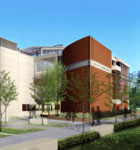MEDIATED LEARNING CENTER
location
Cupertino, CA
size
52,000 square feet
completion
2012 (estimated)
client
De Anza College
architects
Ratcliff Architects
general contractor
Sundt Construction
engineer / lighting designer
WSP Flack + Kurtz
high-performance design consulting
Built Ecology
De Anza College came to its initial meeting with engineering firm WSP Flack + Kurtz with a specific request for its planned Mediated Learning Center: “We want LEED Platinum.” To make it happen, WSP Flack + Kurtz’s high-performance design service, Built Ecology, took on the challenge of optimizing the passive-ventilation system planned by Ratcliff Architects.
client/
De Anza is one of two Foothill-De Anza Community College District campuses in Cupertino and a model of sustainable design. Its Kirsch Center for Environmental Studies was the first building on a community-college campus in the country to achieve LEED Platinum certification, and with the Mediated Learning Center, it wanted to go even further. “They’re very passionate about sustainability,” says Andrew Corney, WSP Flack + Kurtz’s vice president. “At the beginning of the project, the client said, ‘We want to do something innovative; we want to provide leadership in the design community.’” Full of sensitive equipment, however, the center also needed to maintain set-points comparable to an air-conditioned space.
design inspiration/
Corney’s first thought? Hawaii. Built Ecology, a team Corney also leads, had previously worked with the Natural Energy Laboratory of Hawaii Authority to create a system powered by an energy source the authority already had access to: a well of deep sea water. The lab’s Gateway building is entirely conditioned by pumping chilled water from the sea and then using thermal buoyancy to drive the ventilation, Corney explains. “That was one of the projects that inspired us to believe we could apply similar concepts to the Mediated Learning Center,” he says.

A central two-story atrium is key to the Mediated Learning Center’s design. Flanked on the first floor by classrooms, the atrium allows used air to exit the building through apertures in the ceiling. Sun shades, seen along the side, help conserve cooling energy.

Cool air enters through the towers and eventually exits through the atrium skylight, creating a natural chimney effect. In addition, the atrium flooring uses radiant heat to supplement buoyancy return.
layout/
A central two-story atrium is key to the Mediated Learning Center’s design. Flanked on the first floor by classrooms with capacities of around 50 (each of which can be combined with its neighboring classroom to create lecture halls for 100), the sunlight-filled, glass-ceilinged atrium allows used air to exit the building through apertures in the ceiling. It also features an efficient radiant-floor heating system that can warm the building up again after a cool night. The building is oriented so that its façades predominantly face north and south, making it simple to control light using shades on the south side while giving classrooms generous natural illumination. The lighting energy alone, Corney says, is expected to be 40 percent less than the ASHRAE 90.1 standard.
mechanical system/
The energy typically used in mechanical air-conditioning systems for running fans was rerouted to condition the outside air and push it through the building. In the Mediated Learning Center, outside air enters the building through an exterior cooling tower, which uses coils to cool the air to about 65 degrees before letting it drop into the building. The cool air sinks, hits the raised floors in the main-floor classrooms, and then escapes through passive openings in the warm, two-story central atrium’s glass ceiling as it heats and rises.
solar energy/
To counteract some of the energy used in heating and lighting, rooftop solar panels were installed to generate 30 percent of the structure’s energy demand. That figure is more noteworthy than it may seem, Corney says, “given that there is a pretty significant server load attached to the Mediated Learning facilities.” At 6,000 square feet, it’s a pretty big array, he says. A smaller array of solar-thermal collectors provides nearly half of the hot water demands for the building. If any water goes unused, the building can send it into the campus hot-water loop.

